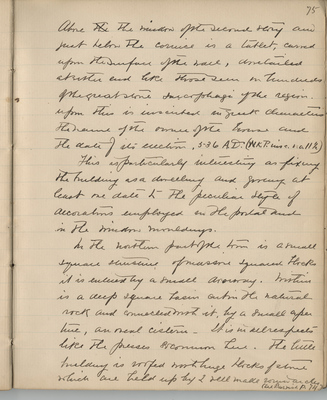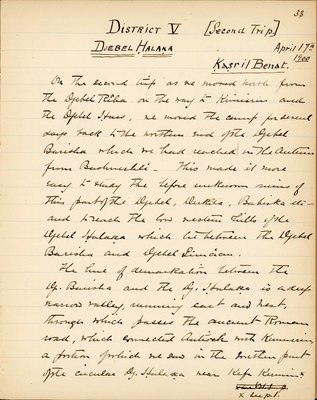Pages That Mention Bashmishli
Butler Diary: Northern and Central Syria I, 1899
BSY_FB_05_p.75
75
Above the window of the second story and just below the cornice is a tablet, carved upon the surface of the wall, dovetailed at either end and like those seen in hundreds of the great stone sarcophagi of the region. Upon this is inscribed in Greek characters the name of the owner of the house and the date of its erection, 536 A.D. (W.K.P. insc. no. 11 ½)
This is particularly interesting as fixing the building as a dwelling and giving at least one date to the peculiar style of decorations employed on the portal and in the window mouldings.
In the northern part of the town is a small square structure of massive squared blocks, it is entered by a small doorway. Within is a deep square basin cut in the natural rock and connected with it, by a small aperture, an oval cistern. It is in all respects like the presses so common here. The little building is roofed with huge blocks of stone which are held up by 2 well-made round arches (see Barrish p. 74)
BSY_FB_05_p.76
76
This is the second example of the use of megalithic ceiling in connexion with arched construction. The other being in Barrish in the Djebel el A'la. This is also the first presumed example of a covered olive or wine press.
To the west, on the edge of the modern valley are found portions of two great columns and an oblong block carved all round with a cornice. These fragments of huge bases, broken shafts and this bit of cornice undoubtedly prove the ^ former ^ existence here of a bicolumnar monument like that at Benâbil and the one described at Sînnada.
This like the Benâbil example seems to have been of purely classic Roman design and undoubtedly dates from the second century A.D. - the first important period of Roman influence here.
End of Part I.
Butler Diary: Northern and Central Syria II, 1899
BSY_FB_06_p001
1
District II. (continued) Djebel Berîsha. (continued) November 6, 1899
Burdj Bāḳirḥa. 20 mins. from Bashmishli
On the northern slope of the mountain, called Ḳublet-Bābuṭṭa, upon a spur of rock, stands the fine ruin of a pagan temple of Roman date, the first certainly classic building that we have found.
The temple faces the East, a considerable portion of the cella, with the entire west wall and gable is still standing. Of the pronaos only a single column and portions of three others are in place. The plan of the temple was a simple prostyle tetrastyle. It seems to have been surrounded by a walled temenos, of which, only a massive pylon, of simple design remains.
This gateway gives the history of the ^ origin of the ^ edifice in a Greek insc.* of good form. It, the pylon, was erected by three men in honor of Zeus in character of the god of the region, in the year 161 A.D.
*see W.K.P. insc. 12.
BSY_FB_06_p030
30
Dêhes. November 2, 10-11, 1899
We passed through this largest of the ruined towns in the northern half of the Djebel Barîsha, on the 2nd, en route for Bashmishli and made some photographs, we returned here to camp over night on the 10th.
The ruins are extensive and interesting comprising a large and a small church, some private houses of special interest and a magnificant rock cut tomb.
E. Church. The larger church is completely ruined nly the south wall, with its two handsome doorways, is standing. The plan seems to have been of type no. 4 with square east end and curved interior apse. There are remains of good carving among the ruins.
South of the apse stands large and well preserved baptistry, of two stories on the exterior, this building is about 20ft square with heavy base mould, and walls unbroken by windows on
Butler Diary: Northern and Central Syria III, 1899
BSY_FB_15-33_0
33
District V (Second Trip)
On the second trip as we moved north from the Djebel Rîhā on the way to Kinnisrin and the Djebel Ḥâṣṣ, we moved the camp for several days back to the northern end of the Djebel Bārîsha which we had reached in the autumn from Bashmishli. This made it more easy to study the before unknown ruins of this part of the Djebel, Dukîta, Bābisḳa, etc - and to reach the low western hills of the Djebel Ḥaluḳa which lie between the Djebel Bārîsha and Djebel Simʿān.
The line of demarcation between the Djebel Bārîsha and the Djebel Ḥaluḳa is a deep narrow valley, running east and west, through which passes the ancient Roman road, which connected Antioch with Kinnisrin , a portion of which we saw in the southern part of the circular Djebel Ḥaluḳa near Kefr Kermîn*
*see p. 1





